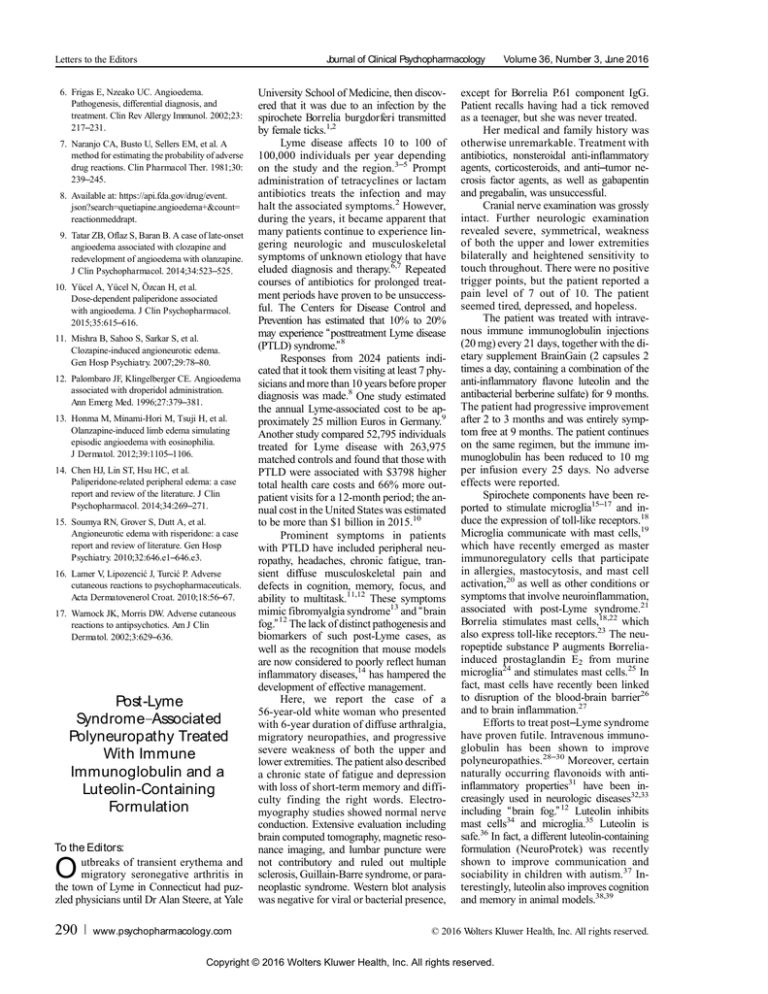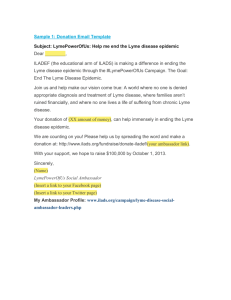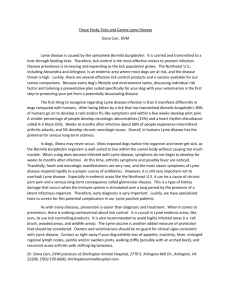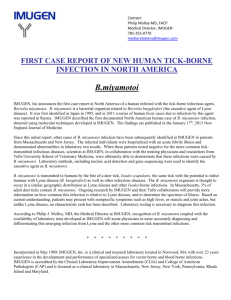
Letters to the Editors
Journal of Clinical Psychopharmacology
6. Frigas E, Nzeako UC. Angioedema.
Pathogenesis, differential diagnosis, and
treatment. Clin Rev Allergy Immunol. 2002;23:
217–231.
7. Naranjo CA, Busto U, Sellers EM, et al. A
method for estimating the probability of adverse
drug reactions. Clin Pharmacol Ther. 1981;30:
239–245.
8. Available at: https://api.fda.gov/drug/event.
json?search=quetiapine.angioedema+&count=
reactionmeddrapt.
9. Tatar ZB, Oflaz S, Baran B. A case of late-onset
angioedema associated with clozapine and
redevelopment of angioedema with olanzapine.
J Clin Psychopharmacol. 2014;34:523–525.
10. Yücel A, Yücel N, Özcan H, et al.
Dose-dependent paliperidone associated
with angioedema. J Clin Psychopharmacol.
2015;35:615–616.
11. Mishra B, Sahoo S, Sarkar S, et al.
Clozapine-induced angioneurotic edema.
Gen Hosp Psychiatry. 2007;29:78–80.
12. Palombaro JF, Klingelberger CE. Angioedema
associated with droperidol administration.
Ann Emerg Med. 1996;27:379–381.
13. Honma M, Minami-Hori M, Tsuji H, et al.
Olanzapine-induced limb edema simulating
episodic angioedema with eosinophilia.
J Dermatol. 2012;39:1105–1106.
14. Chen HJ, Lin ST, Hsu HC, et al.
Paliperidone-related peripheral edema: a case
report and review of the literature. J Clin
Psychopharmacol. 2014;34:269–271.
15. Soumya RN, Grover S, Dutt A, et al.
Angioneurotic edema with risperidone: a case
report and review of literature. Gen Hosp
Psychiatry. 2010;32:646.e1–646.e3.
16. Lamer V, Lipozencić J, Turcić P. Adverse
cutaneous reactions to psychopharmaceuticals.
Acta Dermatovenerol Croat. 2010;18:56–67.
17. Warnock JK, Morris DW. Adverse cutaneous
reactions to antipsychotics. Am J Clin
Dermatol. 2002;3:629–636.
Post-Lyme
Syndrome–Associated
Polyneuropathy Treated
With Immune
Immunoglobulin and a
Luteolin-Containing
Formulation
To the Editors:
utbreaks of transient erythema and
migratory seronegative arthritis in
the town of Lyme in Connecticut had puzzled physicians until Dr Alan Steere, at Yale
O
290
www.psychopharmacology.com
University School of Medicine, then discovered that it was due to an infection by the
spirochete Borrelia burgdorferi transmitted
by female ticks.1,2
Lyme disease affects 10 to 100 of
100,000 individuals per year depending
on the study and the region.3–5 Prompt
administration of tetracyclines or lactam
antibiotics treats the infection and may
halt the associated symptoms.2 However,
during the years, it became apparent that
many patients continue to experience lingering neurologic and musculoskeletal
symptoms of unknown etiology that have
eluded diagnosis and therapy.6,7 Repeated
courses of antibiotics for prolonged treatment periods have proven to be unsuccessful. The Centers for Disease Control and
Prevention has estimated that 10% to 20%
may experience “posttreatment Lyme disease
(PTLD) syndrome.” 8
Responses from 2024 patients indicated that it took them visiting at least 7 physicians and more than 10 years before proper
diagnosis was made.8 One study estimated
the annual Lyme-associated cost to be approximately 25 million Euros in Germany.9
Another study compared 52,795 individuals
treated for Lyme disease with 263,975
matched controls and found that those with
PTLD were associated with $3798 higher
total health care costs and 66% more outpatient visits for a 12-month period; the annual cost in the United States was estimated
to be more than $1 billion in 2015.10
Prominent symptoms in patients
with PTLD have included peripheral neuropathy, headaches, chronic fatigue, transient diffuse musculoskeletal pain and
defects in cognition, memory, focus, and
ability to multitask.11,12 These symptoms
mimic fibromyalgia syndrome13 and “brain
fog.” 12 The lack of distinct pathogenesis and
biomarkers of such post-Lyme cases, as
well as the recognition that mouse models
are now considered to poorly reflect human
inflammatory diseases,14 has hampered the
development of effective management.
Here, we report the case of a
56-year-old white woman who presented
with 6-year duration of diffuse arthralgia,
migratory neuropathies, and progressive
severe weakness of both the upper and
lower extremities. The patient also described
a chronic state of fatigue and depression
with loss of short-term memory and difficulty finding the right words. Electromyography studies showed normal nerve
conduction. Extensive evaluation including
brain computed tomography, magnetic resonance imaging, and lumbar puncture were
not contributory and ruled out multiple
sclerosis, Guillain-Barre syndrome, or paraneoplastic syndrome. Western blot analysis
was negative for viral or bacterial presence,
Volume 36, Number 3, June 2016
except for Borrelia P.61 component IgG.
Patient recalls having had a tick removed
as a teenager, but she was never treated.
Her medical and family history was
otherwise unremarkable. Treatment with
antibiotics, nonsteroidal anti-inflammatory
agents, corticosteroids, and anti–tumor necrosis factor agents, as well as gabapentin
and pregabalin, was unsuccessful.
Cranial nerve examination was grossly
intact. Further neurologic examination
revealed severe, symmetrical, weakness
of both the upper and lower extremities
bilaterally and heightened sensitivity to
touch throughout. There were no positive
trigger points, but the patient reported a
pain level of 7 out of 10. The patient
seemed tired, depressed, and hopeless.
The patient was treated with intravenous immune immunoglobulin injections
(20 mg) every 21 days, together with the dietary supplement BrainGain (2 capsules 2
times a day, containing a combination of the
anti-inflammatory flavone luteolin and the
antibacterial berberine sulfate) for 9 months.
The patient had progressive improvement
after 2 to 3 months and was entirely symptom free at 9 months. The patient continues
on the same regimen, but the immune immunoglobulin has been reduced to 10 mg
per infusion every 25 days. No adverse
effects were reported.
Spirochete components have been reported to stimulate microglia15–17 and induce the expression of toll-like receptors.18
Microglia communicate with mast cells,19
which have recently emerged as master
immunoregulatory cells that participate
in allergies, mastocytosis, and mast cell
activation,20 as well as other conditions or
symptoms that involve neuroinflammation,
associated with post-Lyme syndrome.21
Borrelia stimulates mast cells,18,22 which
also express toll-like receptors.23 The neuropeptide substance P augments Borreliainduced prostaglandin E2 from murine
microglia24 and stimulates mast cells.25 In
fact, mast cells have recently been linked
to disruption of the blood-brain barrier26
and to brain inflammation.27
Efforts to treat post–Lyme syndrome
have proven futile. Intravenous immunoglobulin has been shown to improve
polyneuropathies.28–30 Moreover, certain
naturally occurring flavonoids with antiinflammatory properties31 have been increasingly used in neurologic diseases32,33
including “brain fog.” 12 Luteolin inhibits
mast cells34 and microglia.35 Luteolin is
safe.36 In fact, a different luteolin-containing
formulation (NeuroProtek) was recently
shown to improve communication and
sociability in children with autism.37 Interestingly, luteolin also improves cognition
and memory in animal models.38,39
© 2016 Wolters Kluwer Health, Inc. All rights reserved.
Copyright © 2016 Wolters Kluwer Health, Inc. All rights reserved.
Journal of Clinical Psychopharmacology
Volume 36, Number 3, June 2016
AUTHOR DISCLOSURE
INFORM ATION
T.C.T. is the developer of BrainGain and
NeuroProtek, which have been trademarked
in the United States. He has also been
awarded US patent no. 8,268,365
—“ Anti-inflammatory compositions for
treating brain inflammation.”
The authors declare they have no
other competing interests.
Theohar is C. Theoharides, MS, MPhil,
PhD, MD
Molecular Immunopharmacology and Drug
Discovery Laboratory
Department of Integrative
Physiology and Pathobiology
Tufts University School of Medicine and
Departments of Internal Medicine and Psychiatry
Tufts University School of Medicine and Tufts
Medical Center
Boston, MA
theoharis.theoharides@tufts.edu
Julia M. Stewar t, RN
Molecular Immunopharmacology and Drug
Discovery Laboratory
Department of Integrative
Physiology and Pathobiology
Tufts University School of Medicine
Boston, MA
REFERENCES
1. Steere AC, Malawista SE, Snydman DR, et al.
Lyme arthritis: an epidemic of oligoarticular
arthritis in children and adults in three
Connecticut communities. Arthritis Rheum.
1977;20:7–17.
2. Arvikar SL, Steere AC. Diagnosis and
treatment of Lyme arthritis. Infect Dis Clin
North Am. 2015;29:269–280.
3. Nelson CA, Saha S, Kugeler KJ, et al. Incidence
of clinician-diagnosed Lyme disease,
United States, 2005-2010. Emerg Infect Dis.
2015;21:1625–1631.
4. Mead PS. Epidemiology of Lyme disease. Infect
Dis Clin North Am. 2015;29:187–210.
5. Hofhuis A, Harms M, Bennema S, et al.
Physician reported incidence of early and late
Lyme borreliosis. Parasit Vectors. 2015;8:161.
6. Miklossy J, Kasas S, Zurn AD, et al. Persisting
atypical and cystic forms of Borrelia burgdorferi
and local inflammation in Lyme neuroborreliosis.
J Neuroinflammation. 2008;5:40.
7. Crowder LA, Yedlin VA, Weinstein ER, et al.
Lyme disease and post-treatment Lyme disease
syndrome: the neglected disease in our own
backyard. Public Health. 2014;128:784–791.
8. Johnson L, Aylward A, Stricker RB. Healthcare
access and burden of care for patients with
Lyme disease: a large United States survey.
Health Policy. 2011;102:64–71.
9. Lohr B, Müller I, Mai M, et al. Epidemiology
and cost of hospital care for Lyme borreliosis in
Germany: lessons from a health care utilization
database analysis. Ticks Tick Borne Dis.
2015;6:56–62.
10. Adrion ER, Aucott J, Lemke KW, et al. Health
care costs, utilization and patterns of care
following Lyme disease. PLoS One. 2015;
10:e0116767.
11. Koedel U, Fingerle V, Pfister HW. Lyme
neuroborreliosis-epidemiology, diagnosis and
management. Nat Rev Neurol. 2015;11:446–456.
12. Theoharides TC, Stewart JM, Hatziagelaki E,
et al. Brain “fog,” inflammation and obesity: key
aspects of neuropsychiatric disorders improved
by luteolin.Front Neurosci. 2015;9:225.
13. Theoharides TC, Tsilioni I, Arbetman L, et al.
Fibromyalgia, a syndrome in search of
pathogenesis and therapy. J Pharmacol Exp
Ther. 2015;355:255–263.
14. Seok J, Warren HS, Cuenca AG, et al. Genomic
responses in mouse models poorly mimic
human inflammatory diseases. Proc Natl Acad
Sci U S A. 2013;110:3507–3512.
Letters to the Editors
26. Esposito P, Chandler N, Kandere-Grzybowska K,
et al. Corticotropin-releasing hormone (CRH)
and brain mast cells regulate blood–brain-barrier
permeability induced by acute stress.
J Pharmacol Exp Ther 2002;303:1061–1066.
27. Polyzoidis S, Koletsa T, Panagiotidou S, et al.
Mast cells in meningiomas and brain
inflammation. J Neuroinflammation. 2015;12:170.
28. Crisp D, Ashby P. Lyme radiculoneuritis treated
with intravenous immunoglobulin. Neurology.
1996;46:1174–1175.
29. Srivastava R, Ramakrishna C, Cantin E.
Anti-inflammatory activity of intravenous
immunoglobulins protects against West Nile
virus encephalitis. J Gen Virol. 2015;96(pt 6):
1347–1357.
30. Kaveri SV, Lecerf M, Saha C, et al.
Intravenous immunoglobulin and immune
response. Clin Exp Immunol. 2014;178
(suppl 1):94–96.
15. Myers TA, Kaushal D, Philipp MT. Microglia
are mediators of Borrelia burgdorferi-induced
apoptosis in SH-SY5Y neuronal cells. PLoS
Pathog. 2009;5:e1000659.
31. Middleton EJ, Kandaswami C, Theoharides TC.
The effects of plant flavonoids on mammalian
cells: implications for inflammation, heart
disease and cancer. Pharmacol Rev.
2000;52:673–751.
16. Ramesh G, Borda JT, Gill A, et al. Possible role
of glial cells in the onset and progression of
Lyme neuroborreliosis. J Neuroinflammation.
2009;6:23.
32. Grosso C, Valentão P, Ferreres F, et al. The use
of flavonoids in central nervous system
disorders. Curr Med Chem. 2013;20:
4694–4719.
17. Rasley A, Anguita J, Marriott I. Borrelia
burgdorferi induces inflammatory mediator
production by murine microglia.
J Neuroimmunol. 2002;130:22–31.
33. Jones QR, Warford J, Rupasinghe HP, et al.
Target-based selection of flavonoids for
neurodegenerative disorders. Trends Pharmacol
Sci. 2012;33:602–610.
18. Bernardino AL, Myers TA, Alvarez X, et al.
Toll-like receptors: insights into their possible role
in the pathogenesis of Lyme neuroborreliosis.
Infect Immun. 2008;76:4385–4395.
34. Weng Z, Patel AB, Panagiotidou S, et al. The
novel flavone tetramethoxyluteolin is a potent
inhibitor of human mast cells. J Allergy Clin
Immunol. 2014;14:1044–1052.
19. Skaper SD, Facci L, Giusti P. Mast cells, glia
and neuroinflammation: partners in crime?
Immunology. 2014;141:314–327.
35. Jang S, Kelley KW, Johnson RW. Luteolin
reduces IL-6 production in microglia by
inhibiting JNK phosphorylation and activation
of AP-1. Proc Natl Acad Sci U S A. 2008;105:
7534–7539.
20. Theoharides TC, Valent P, Akin C. Mast cells,
mastocytosis, and related disorders. N Engl J
Med. 2015;373:163–172.
21. Theoharides TC. Atopic conditions in search of
pathogenesis and therapy. Clin Ther. 2013;35:
544–547.
22. Talkington J, Nickell SP. Borrelia burgdorferi
spirochetes induce mast cell activation and
cytokine release. Infect Immun. 1999;67:
1107–1115.
23. Abraham SN, St John AL. Mast
cell-orchestrated immunity to pathogens.
Nat Rev Immunol. 2010;10:440–452.
36. Theoharides TC, Conti P, Economu M.
Brain inflammation, neuropsychiatric
disorders, and immunoendocrine effects
of luteolin. J Clin Psychopharmacol.
2014;34:187–189.
37. Taliou A, Zintzaras E, Lykouras L, et al.
An open-label pilot study of a formulation
containing the anti-inflammatory flavonoid
luteolin and its effects on behavior in children
with autism spectrum disorders. Clin Ther.
2013;35:592–602.
24. Rasley A, Marriott I, Halberstadt CR, et al.
Substance P augments Borrelia
burgdorferi-induced prostaglandin E2
production by murine microglia. J Immunol.
2004;172:5707–5713.
38. Yoo DY, Choi JH, Kim W, et al. Effects of
luteolin on spatial memory, cell proliferation,
and neuroblast differentiation in the
hippocampal dentate gyrus in a
scopolamine-induced amnesia model. Neurol
Res. 2013;35:813–820.
25. Theoharides TC, Zhang B, Kempuraj D, et al.
IL-33 augments substance P-induced VEGF
secretion from human mast cells and is
increased in psoriatic skin. Proc Natl Acad Sci
U S A. 2010;107:4448–4453.
39. Liu R, Gao M, Qiang GF, et al. The anti-amnesic
effects of luteolin against amyloid beta(25–35)
peptide-induced toxicity in mice involve the
protection of neurovascular unit. Neuroscience.
2009;162:1232–1243.
© 2016 Wolters Kluwer Health, Inc. All rights reserved.
www.psychopharmacology.com
Copyright © 2016 Wolters Kluwer Health, Inc. All rights reserved.
291





